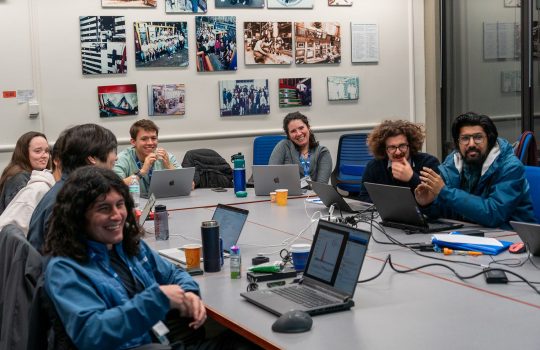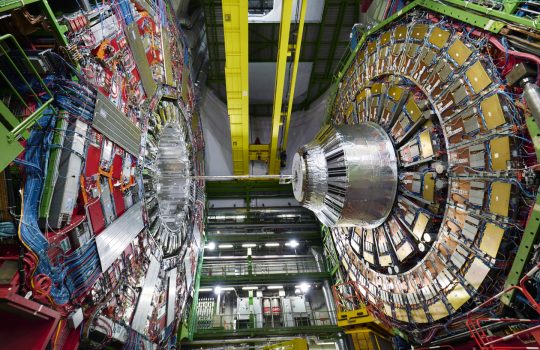BATAVIA, IL and UPTON, NY – The world’s largest computing grid has passed its most comprehensive tests to date in anticipation of the restart of the world’s most powerful particle accelerator, the Large Hadron Collider (LHC). The successful dress rehearsal proves that the Worldwide LHC Computing Grid (WLCG) is ready to analyze and manage real data from the massive machine. The United States is a vital partner in the development and operation of the WLCG, with 15 universities and three U.S. Department of Energy (DOE) national laboratories from 11 states contributing to the project.
The full-scale test, collectively called the Scale Test of the Experimental Program 2009 (STEP09), demonstrates the ability of the WLCG to efficiently navigate data collected from the LHC’s intense collisions at CERN, in Geneva, Switzerland, all the way through a multi-layered management process that culminates at laboratories and universities around the world. When the LHC resumes operations this fall, the WLCG will handle more than 15 million gigabytes of data every year.
Although there have been several large-scale WLCG data-processing tests in the past, STEP09, which was completed on June 15, was the first to simultaneously test all of the key elements of the process.
“Unlike previous challenges, which were dedicated testing periods, STEP09 was a production activity that closely matches the types of workload that we can expect during LHC data taking. It was a demonstration not only of the readiness of experiments, sites and services but also the operations and support procedures and infrastructures,” said CERN’s Ian Bird, leader of the WLCG project.
Once LHC data have been collected at CERN, dedicated optical fiber networks distribute the data to 11 major “Tier-1” computer centers in Europe, North America and Asia, including those at DOE’s Brookhaven National Laboratory in New York and Fermi National Accelerator Laboratory in Illinois. From these, data are dispatched to more than 140 “Tier-2” centers around the world, including 12 in the United States. It will be at the Tier-2 and Tier-3 centers that physicists will analyze data from the LHC experiments – ATLAS, CMS, ALICE and LHCb – leading to new discoveries. Support for the Tier-2 and Tier-3 centers is provided by the DOE Office of Science and the National Science Foundation.
“In order to really prove our readiness at close-to-real-life circumstances, we have to carry out data replication, data reprocessing, data analysis, and event simulation all at the same time and all at the expected scale for data taking,” said Michael Ernst, director of Brookhaven National Laboratory’s Tier-1 Computing Center. “That’s what made STEP09 unique.”
The result was “wildly successful,” Ernst said, adding that the U.S. distributed computing facility for the ATLAS experiment completed 150,000 analysis jobs at an efficiency of 94 percent.
A key goal of the test was gauging the analysis capabilities of the Tier 2 and Tier 3 computing centers. During STEP09’s 13-day run, seven U.S. Tier 2 centers for the CMS experiment, and four U.S. CMS Tier 3 centers, performed around 225,000 successful analysis jobs.
“We knew from past tests that we wanted to improve certain areas,” said Oliver Gutsche, the Fermilab physicist who led the effort for the CMS experiment. “This test was especially useful because we learned how the infrastructure behaves under heavy load from all four LHC experiments. We now know that we are ready for collisions.”
U.S. contributions to the WLCG are coordinated through the Open Science Grid (OSG), a national computing infrastructure for science. OSG not only contributes computing power for LHC data needs, but also for projects in many other scientific fields including biology, nanotechnology, medicine and climate science.
“This is another significant step to demonstrating that shared infrastructures can be used by multiple high-throughput science communities simultaneously,” said Ruth Pordes, executive director of the Open Science Grid Consortium. “ATLAS and CMS are not only proving the usability of OSG, but contributing to maturing national distributed facilities in the U.S. for other sciences.”
Physicists in the U.S. and around the world will sift through the LHC data in search of tiny signals that will lead to discoveries about the nature of the physical universe. Through their distributed computing infrastructures, these physicists also help other scientific researchers increase their use of computing and storage for broader discovery.
Grid computing and Large Hadron Collider images are available at http://www.uslhc.us/Images. More information about U.S. computing for the LHC, including a list of U.S. institutions involved in the Worldwide LHC Computing Grid, is available at http://www.uslhc.us/The_US_and_the_LHC/Computing.
U.S. support for LHC participation
The U.S. Department of Energy (DOE) Office of Science and the National Science Foundation (NSF) invested a total of $531 million in the construction of the Large Hadron Collider and the ATLAS and CMS detectors. DOE provided $200 million for the construction of critical LHC accelerator components, $250 million for the design and construction of the ATLAS and CMS detectors, and continues to support U.S. scientists’ work on the detectors and accelerator R&D. NSF has focused its support on funding university scientists who have contributed to the design and construction of CMS and ATLAS ($81 million). In addition, both agencies promote the development of advanced computing innovations to meet the enormous LHC data challenge. More than 1,700 scientists, engineers, students and technicians from 94 U.S. universities and laboratories participate in the LHC and its experiments. (A full list is available here.)
LHC Computing Grid participants
Signatories to the Worldwide LHC Computing Grid are: Australia, Austria, Belgium, Canada, China, the Czech Republic, Denmark, Estonia, Finland, France, Germany, Hungary, Italy, India, Israel, Japan, Republic of Korea, the Netherlands, Norway, Pakistan, Poland, Portugal, Romania, the Russian Federation, Slovenia, Spain, Sweden, Switzerland, Taipei, Turkey, the United Kingdom, Ukraine, and the United States of America.
Brookhaven National Laboratory is operated and managed for DOE’s Office of Science by Brookhaven Science Associates. Visit Brookhaven Laboratory’s electronic newsroom for links, news archives, graphics, and more.
Fermilab is a DOE Office of Science national laboratory, operated under contract by the Fermi Research Alliance, LLC. The Department of Energy Office of Science is the nation’s single-largest supporter of basic research in the physical sciences.
The Open Science Grid is a national distributed computing grid for data-intensive research, supported by the Offices of Advanced Scientific Computing Research, High Energy Physics, and Nuclear Physics within the DOE Office of Science, and the National Science Foundation. Visit www.opensciencegrid.org.
CERN, the European Organization for Nuclear Research, is the world’s leading laboratory for particle physics. It has its headquarters in Geneva. At present, its Member States are Austria, Belgium, Bulgaria, the Czech Republic, Denmark, Finland, France, Germany, Greece, Hungary, Italy, Netherlands, Norway, Poland, Portugal, Slovakia, Spain, Sweden, Switzerland and the United Kingdom. India, Israel, Japan, the Russian Federation, the United States of America, Turkey, the European Commission and UNESCO have Observer status.



